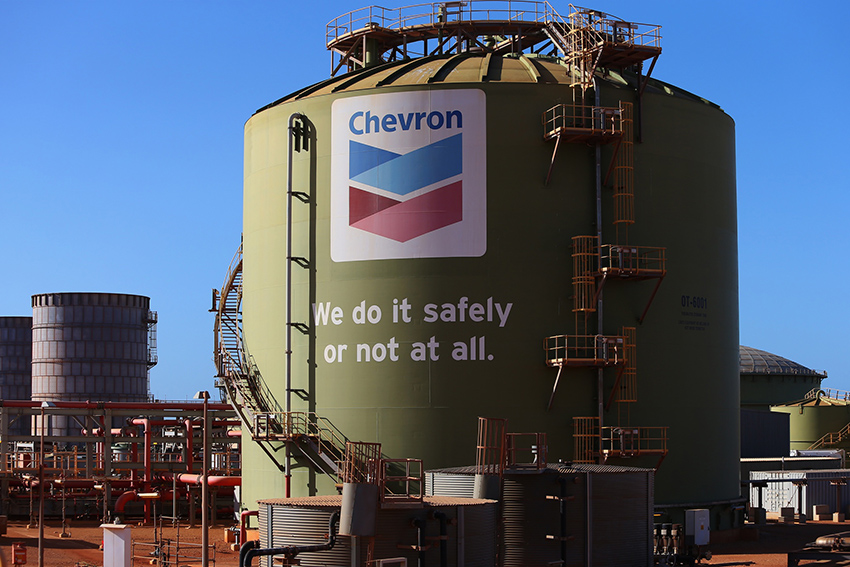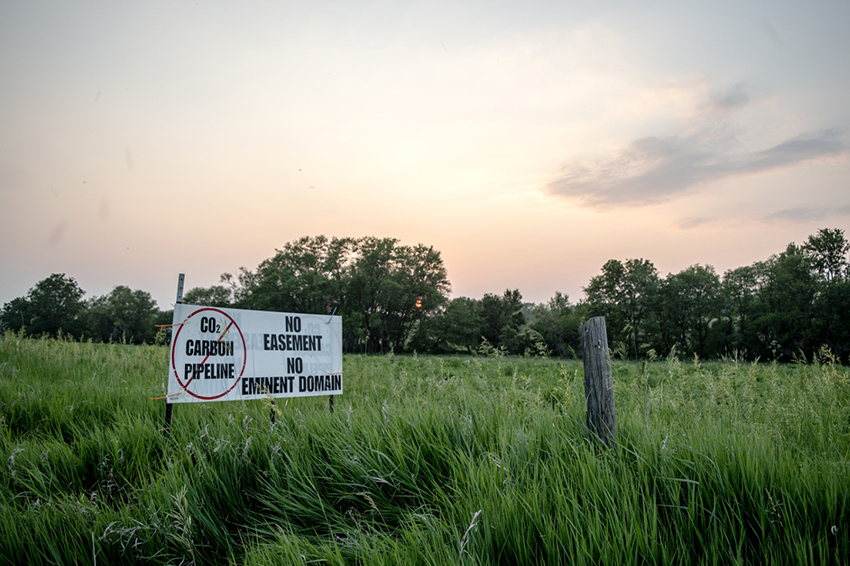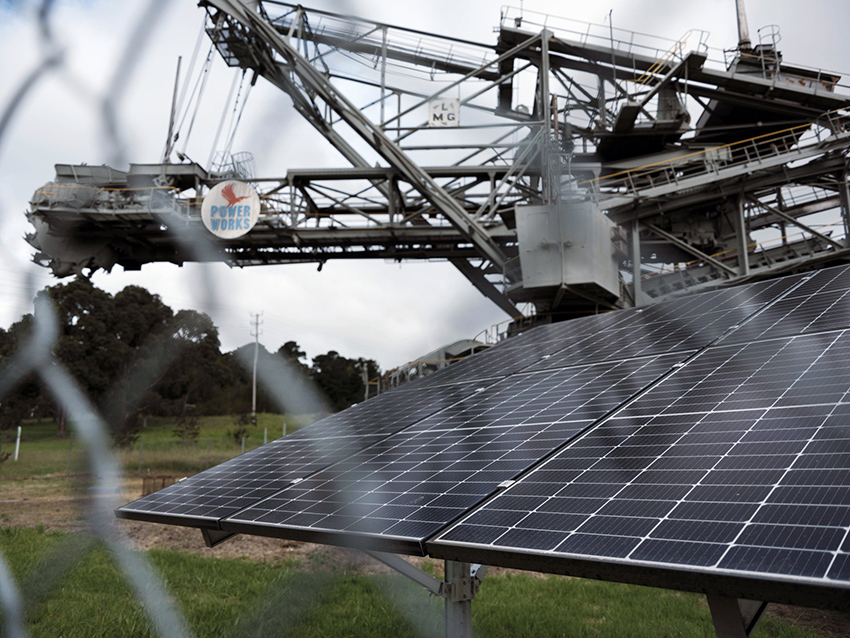|

December 12, 2023
By Jennifer A Dlouhy and Akshat Rathi
Carbon capture
isn’t an easy fix
Big Oil's favorite solution
Nearly 200 countries are in the home stretch of
tough negotiations at COP28 over what the world should do to combat
climate change. A central debate is about whether to quickly phase out
fossil fuels or continue to burn them while banking on technologies
that have the potential to mitigate their emissions.
The bet rests on carbon capture and storage (CCS), a process that
traps carbon dioxide from factories or power plants and buries it
away. Oil companies have been employing the technology for decades but
mostly pumped the trapped CO2 back into the ground to extract more
fossil fuel. Today, there’s increasing interest in using CCS to reduce
the carbon intensity of products, such as cement and steel, and even
suck CO2 directly out of the air.

A fire water tank at the Gorgon liquefied natural
gas and carbon capture and storage facility, operated by Chevron
Corp., on Barrow Island, Australia. Photographer: Lisa Maree
Williams/Bloomberg
Deploying CCS is so energy intensive and expensive, said Emily Grubert,
a professor at the University of Notre Dame. “If you're not required
to do it, you're not going to do it.”
That’s where governments think they can make a difference. At the
United Nations summit in Dubai, many of the world’s largest economies
are pledging to redouble efforts to back CCS through subsidies. Carbon
capture projects have now been announced on every inhabited continent.
But the big question remains: Will that be enough to arrest the
dangerous climb in global temperatures?
One country provides an instructive example. For decades, the US has
dedicated billions of dollars in federal government spending — both
grants and tax credits — to propel carbon capture ventures at power
plants and industrial facilities, but it has little to show for that
largesse. Just 14 projects are operating today, with half of them tied
to the very cheapest applications — gas processing and ethanol
production — according to a database by the non-governmental
organization Clean Air Task Force.
Bigger tax credits expanded by the Inflation Reduction Act have
supercharged interest in the sector, says Jessie Stolark, executive
director of the US group Carbon Capture Coalition. But while more than
150 projects have been announced, those ventures may take five to
seven years to build and some may never result in steel in the ground.
Bloomberg Originals looks at why carbon capture
is Big Oil’s favorite climate solution.
For years, anyone trying to sell a carbon capture project in the US
had to navigate a complicated and expensive path to monetize the tax
credits. To lure in project financing from the tax equity market, for
instance, developers often found themselves forfeiting 30% of the
value of the credit right from the start — essentially shedding some
$15 off the max $50-per-ton credit in late 2018.
The IRA boosted that credit to $85 per ton while also allowing some
credits to be paid out in cash. Raising capital is still tough, but
the financial case has become clearer for both investors and
developers.
A major problem is that the US has undermined its generosity for CCS
with an incentive-only approach, says Ben Longstreth, global director
for carbon capture at the CATF. “The carrots have been too small for
most carbon capture applications,” he said, about the tax credits and
other incentives the government provides.
The US is only beginning to dabble with mandates for carbon capture in
the form of a proposed Environmental Protection Agency requirement for
some natural gas power plants to adopt the technology toward the end
of the next decade. But the requirement would only apply to a sliver
of gas plants, and some owners may shutter facilities — or simply
curtail their operation — to avoid the regulation.
Developers also face enormous logistical and permitting hurdles — with
big, project-killing fights over new proposed pipelines to carry
carbon dioxide as well as the injection wells to store the gas
underground. It took six years before the federal government approved
the first wells. The EPA now has a list of nearly 200-and-growing
awaiting review.

A sign against a proposed carbon
dioxide pipeline outside a home in New Liberty, Iowa on June 4.
Photographer: Miriam Alarcon Avila/Bloomberg
Some states, including Louisiana, are hoping to
take the lead role vetting potential carbon storage wells within their
borders, which would help ease the backlog. But those plans pit state
authorities against residents who’ve spent their lives living next to
petrochemical facilities and are leery of local oversight as well as
the risks of residing near CO2 dumping grounds.
A lack of pipelines is an even bigger problem, particularly for
ethanol factories in the rural Midwest, which can trap gas at a
relatively cheap price but don't have many underground storage
opportunities. Those facilities will depend on pipelines to take the
gas to far-off repositories along the Gulf Coast or further north.
Proposed CO2 pipelines in the region have met fierce resistance from
local landowners, with opposition prompting one group of developers to
cancel the $3.5 billion Navigator Heartland Greenway project in
October. The outlook is bearish for the other pipelines waiting in the
wings, said James Lucier, managing director at research group Capital
Alpha Partners.
“Not even tens of billions of dollars in carbon sequestration tax
credits will make the pipelines move any faster,” Lucier told clients
in a research note that soberly predicted no new CO2 pipelines will be
built in the US before 2026.
For opponents, the massive web of infrastructure needed to support CCS
is reason enough not to pursue it at all. “We're talking about decadal
infrastructure — things that have expected economic lives that are
quite long and payback periods and financing that stretches from years
to decades,” said Steven Feit, senior attorney with the Center for
International Environmental Law.
Click here to
continue reading the full story as it appeared on Bloomberg.com.
This
might fix things
$100
That’s the cost per ton of CO2 that the carbon-removal industry needs
to reach in order to be competitive.
Yet,
it's still tricky tech
"Carbon capture technologies are precious, they're incredibly energy
intensive, they involve a lot of demand for storage that takes a lot
from the communities that host it. We really need to be extremely
pointed with where we're talking about deploying this."
Emily Grubert
Professor of sustainable energy policy at Notre Dame
More from Green
It’s a persistent global conundrum: Can policymakers close coal mines
and power plants without ruining local economies in the process? If
you take a two-hour drive east from Melbourne into the Latrobe Valley,
the answer appears to be Yes.
After almost a century as Victoria’s central provider of electricity,
most of the area’s mines and coal-fired power stations are scheduled
to close between 2028 and 2035, if they haven’t already. Yet Latrobe
and the broader Gippsland area have kept decline and diseases of
despair at bay, with plans for solar farms, battery storage and the
country’s first offshore wind installations. Unemployment is low and
the population — currently about 300,000 — is growing, along with
household income. Real estate values are rising.
“There is a confidence, in the community, that we’re going to be
okay,” said Chris Buckingham, head of the Latrobe Valley Authority, a
regional agency created in 2016 to help manage the coming energy
transition. “This is not a smiling-while-drowning conversation, right?
This is about, if we get this right, if we work together in a
harmonious way, we’re far more likely to come out ahead.”

Old coal mining equipment next to solar panels at the
PowerWorks Energy Education Centre in Morwell, Australia, on Dec. 1.
Photographer: James Bugg/Bloomberg
Green Play Ammonia™, Yielder® NFuel Energy.
Spokane, Washington. 99212
509 995 1879
Cell, Pacific Time Zone.
General office:
509-254
6854
4501 East Trent
Ave.
Spokane, WA 99212
|